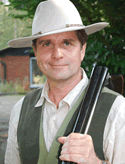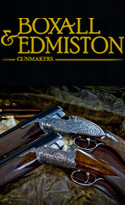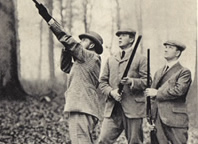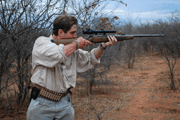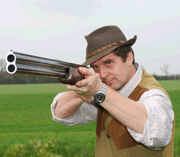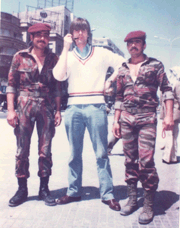Early Targets, Competitions and the Invention of Clay Pigeons
Potatoes and all manner of other objects have been used as inanimate moving targets (one famous Victorian shooting match involved cricket balls launched by a fast bowler) but the most direct ancestor of the modern clay pigeon is the glass ball target. It was probably invented in England but popularised and refined in America by Charlie Portlock of Boston, who introduced the first glass ball targets in the U.S.A. in 1866. The first major shoot in the United States (and, indeed, the first recorded shoot) took place in Boston’s Beacon Park in 1867. Glass balls were used in quantity from this time. The sport developed in parallel to live bird shooting to which it was a cheaper and more humane alternative (as clay shooting would soon become as well).
The balls were typically fired from a trap that looked like a miniature version of the siege catapults used by the Romans. The basic form simply consisting of a launching cup on the end of a long leaf-spring. Single traps were the norm, but double traps existed too with designs becoming more complex as the sport developed. The 1892 edition of Greener’s great work The Gun And Its Development notes, for example, Card’s Standard revolving double trap of which it records: “The revolving is the latest American improved trap; it will project one or two balls in any direction (except towards the shooter), or it will rotate throwing balls in a direction impossible to foresee”.[p.562-563].
As with live bird shooting, there were many famous shooting matches, involving legendary characters like “Doc” Carver, Ira Payne and, not least, Captain Adam Bogardus self-styled Champion of the World. The stakes could be vast, $10,000 was not unknown, which must be more like 1,000,000 in today’s money. The record for glass ball shooting stands with Bogardus, who once shot 6,000 glass balls for 6,013 shots expended. Anyone who saw the recent episode of what the Victorian’s Did For Us on BBC 2 (inlcuding the replica ‘knicker elastic’ powered ball trap)will realise some of the practical difficulties involved!
In its earliest form, the glass target was no more than a smooth globe about 2 1/4” in diameter. But the targets soon became more sophisticated. The glass was coloured amber or blue to improve visibility and the surface of the balls was roughened or ridged to improve the breaking qualities of the targets. Bogardus - who was always looking for ways to cash in on his sport - patented a better ball and trap. An advertisement of 1879 informed: “Bogardus Patent Rough Glass Balls are made of uniform weight and thickness, and have a corrugated surface that strengthens the ball for shipment to any part of the country, prevents the glancing of shot, and thereby ensures the breaking of the ball when hit. Buy none but the best, and patronise the man who has spent both time and money to introduce glass ball shooting to the sporting public, until it has become a national pastime.” Another roughened ball target was made in enormous quantity by Sears & Roebuck. Ira Payne introduced feathers into his balls to increase realism, others tried flour, dust, or shredded newspaper; some targets were even made to explode.
Although they were popular in their day (and continued to be used well into the twentieth century for exhibition shooting) the problem with the glass targets was the shards they left behind on the shooting field when shattered. This deficiency was recognised and various composition targets were patented and manufactured. Greener makes mention of pitch and of concrete balls and even patented a re-useable wooden ball with an explosive coating. The forerunner of the ecologically friendly clay was a ball target designed to break down into fertiliser. As unusual, and no more successful, was a brass globe filled with charcoal dust. There were other weird and wonderful contrivances, for example, the Best Tin Pigeon and Macomber’s Metal Flyer. Belcher’s Patent Paper Bird was “an oddly shaped bit of stiff paper attached to a wire ball”. The Globe Flight was a pasteboard disc with a small balloon at its centre (the resulting target looked rather like Saturn and its rings). Various mechanical targets appeared and disappeared. The only one to achieve a modicum of success was Bussey’s Gyro Pigeon (which inspired the modern ZZ target).
Invention of the clay pigeon
Glass targets were eventually superseded by “mud saucers” or, as they quickly came to be known - clay pigeons. They acquired both names because the early disc targets were literally made of clay rather than the modern mixture of pitch and limestone). The new target was not only friendlier to the environment, but flew far better than the ball or any of the other inanimate birds. Just who invented the clay target is subject to some controversy, though. By most accounts, the honour goes to George Ligowsky of Ohio who was granted a U.S. patent in 1880. Legend has it that Ligowsky got his idea for a disc target whilst watching boys “skimming clam shells across the water”. Another American, Nicholas Fischer, also laid claim to the invention (and was granted a U.S. patent in 1883) but this went to law with Ligowsky’s company winning a protracted battle and eventually being awarded costs.
It is interesting to note W.W.Greener’s comment in 1892 that: “… [ball targets] have been superseded by the Ligowsky Clay Pigeon-Trap and Pigeons. The “pigeons” also called mud saucers…are very thin, concave below and convex above, and are skimmed from the trap with a most irregular flight…For officers in the army and sportsmen in the summer months they offer a never-ending source of amusement.”[p.564, the Gun and Its Development, 5th Edition, Cassell & Co., London,1892]
The sport of clay shooting certainly established itself at astounding speed. There was an exhibition of the new pastime on Coney Island in 1880 (as a side-show to a large live bird event). By 1885, the first national tournament was held in New Orleans and by 1892, American shooters were consuming millions of targets a year. One reason for this spectacular success was that the canny Ligowsky had hired Bogardus and Carver (the latter otherwise employed by Buffalo Bill’s Wild West show) to tour the country and demonstrate his new product. The promotion worked rather too well. Ligowsky soon found himself with all sorts of competitors who wanted to cash in on the clay shooting boom. Things did not happen quite so rapidly, or with as much razzmatazz, in Britain. Nevertheless, in the Illustrated London News of March 10, 1883, one finds an engraving of “Terracota Pigeon” shooting at the Ranelagh club, London. It is the first reference to clay shooting in England of which I am aware. A year later, 1884, there is a record of a clay pigeon club having formed at Botley in Hampshire.
Manufacture of early clay targets
The earliest true clay targets were baked, much like bricks, in moulds in an oven . D.H. Eaton, the author of Trapshooting: the Patriotic Sport, an American work, writes in 1920:
The [early] birds were made entirely of clay, cast iron moulds being used. An iron plate was laid in a long narrow furnace, at one of which was the fire, and on this plate the moulds were placed to be heated. The clay was ground very fine and mixed with water to a consistency very little thicker than water. Each mould was filled with this mixture through a hose; after the mould-filler came a second man who, by means of suction, removed from each mould as much of the mixture as had not hardened. A third man removed the dry clay from the moulds. The birds were then placed in a kiln and burned like bricks. The result was an extremely hard target, ringing like a bell when hit, and almost impossible to break. It often happened that a quartering target would be knocked completely off its course without breaking off the smallest chip, an examination of the target showing the marks of the shot plainly visible.
Composition targets, a most important development, were introduced in the United States in about 1884. These were easier to break than the early clay birds. The names chiefly associated with the improved targets are McCaskey (“an Englishman”) and Fred Kimble, the famous American market hunter (also credited as one of the fathers of modern choke boring). McCaskey's targets-made of limestone and pitch-were marketed as “Blue Rocks”. Kimble’s-a mixture of river silt and plaster of Paris-became famous as the “Peoria Blackbird”.
The limitations of early targets did not just concern their composition and poor breaking qualities. They were equipped with a small tongue of card glued to their edge that was held by a pincher at the end of the trap arm (this allowed for the clay to be held more or less securely in the trap arm). Unfortunately, this tab could be damaged or become unglued in wet weather. The problem was partially rectified by including the tongue in the moulding. It was later dispensed with by improving the manner in which the trap arm gripped the target.
By the end of the nineteenth century, the development of the clay target and basic manual trap was just about complete. In the U.S.A., magazine-fed traps appeared in the late 1890’s and were soon much improved. A practical lever trap - a style which would become very popular with trap shooters - was offered by the Chamberlain Cartridge Company in 1903. Developments in England had followed those in the U.S. In the late 1880’s, the English firm, Cogswell and Harrison, offered an improved trap, the Swiftsure. The company also began manufacture of a composition clay. In England - where organised clay shooting was yet to become a major sport - an improved trap and clay target were especially attractive to the new shooting schools which were becoming fashionable in the 1890s.


